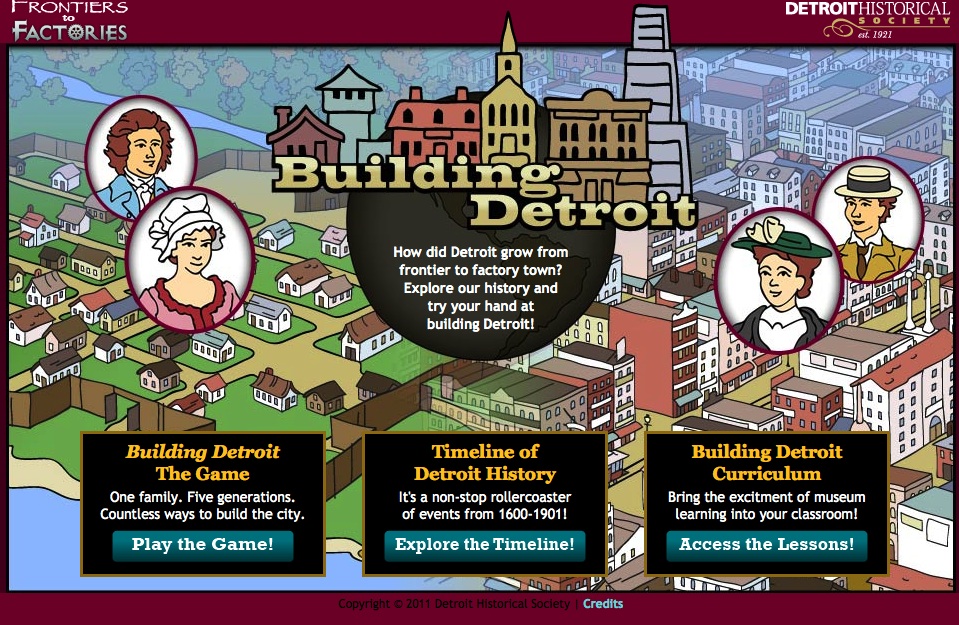
The Detroit Historical Museum lets visitors to its website help build Detroit.
Literally.
In the game “Building Detroit”, players take on the role of an early French settler from 1750, followed by four succeeding generations of this particular family, as Detroit grows from a small settlement into a bustling city.
The game is set in the 1750s, 1790s, 1820s, 1860s and 1890s, concluding in the year 1906. At the first level, the player’s settler character is a famer who must choose which crops to plant (either the reliable “three sisters” of beans, corns and squash or the more risky but potentially high yield wheat); whether to purchase a steel-edged plow or a cheaper iron one and other decisions.
From the second level on, players can opt to pursue a variety of careers and decide where to set up their businesses and establish their homes, and whether their children will go to school, work for the family business or work elsewhere.
Career options (depending on the level a player is on) include operating a trading post, being a tavern keeper, running a general store, being a stove builder and being a manufacturer.
From time to time, players can opt to change careers or change certain element about their businesses, such as location, types of materials bought, types of advertising bought and how employees are paid.
At the end of the game, if the player’s character has amassed sufficient wealth, he or she can choose to contribute money to build a museum or a skyscraper or to start a charity.
From time to time in the course of the game, a “newspaper” pops up with brief stories about some key aspect related to Detroit history in a given set of years. Several of the headlines have a humorous bent, such as this “New France News” from 1762:
French Setters: “The British own Detroit Now? Whatever.”
Or this “headline” from a 1798 edition of the “Upper Canada Chronicle”:
Americans to British: “Get Out and Stay Out!”
Or this 1802 “edition”:
Detroit: “Look! We are a Town! With Buildings and Everything!”
Or these two from “The Detroit Frontier Times” in 1824 and 1828, respectively:
Detroit: “We Aren’t a Giant Swampy Mess. Seriously!”
Detroit: “See, We Told You We Weren’t a Swampy Mess!”
The brief “stories” related to the above headlines discuss the outcome of the French and Indian War in which the British gained control of the region; how the Americans finally were able to take control in 1796, 13 years after the end of the revolutionary War; the growth of Detroit into a town; the mistaken belief that Michigan, especially what is now the Metro Detroit area, was a swamp; and how the completion of the Erie Canal allowed settlers to come to Detroit by relatively fast means and see it for themselves.
Other “headlines” relate how Michigan lost Toledo in exchange for getting the Upper Peninsula (and the subsequent discovery of abundant natural resources in the UP) as well as Detroit’s determination to “rise from the ashes” after the 1805 fire destroyed the town.
Not only can visitors to the Detroit Historical Museum Website play the game, they can also click on a timeline of Detroit history or access PDF lessons in a Building Detroit Curriculum. All of these options are related to the museum’s “Frontiers to Factories” exhibit.
The timeline provides information in the categories “milestones”, “industry”, “people” and “events”, and includes such information as the fact that African Americans were admitted to public schools in Detroit in 1869; the first policewoman in the United States was Marie Owen in 1893; and that Ransom Olds produced the first practical American car in 1901. It cost $650 and could reach speeds as high as 18 MPH.
The lessons are divided into six sections: “Before 1701: the People of the Three Fires”; 1701-1760: French Detroit; “1761-1796: British Detroit”; “1796-1825: American Detroit”; “1825-1865: Boomtown Detroit”; and “1866-1901: Industrial Detroit.
Visit https://detroithistorical.org/buildingdetroit/